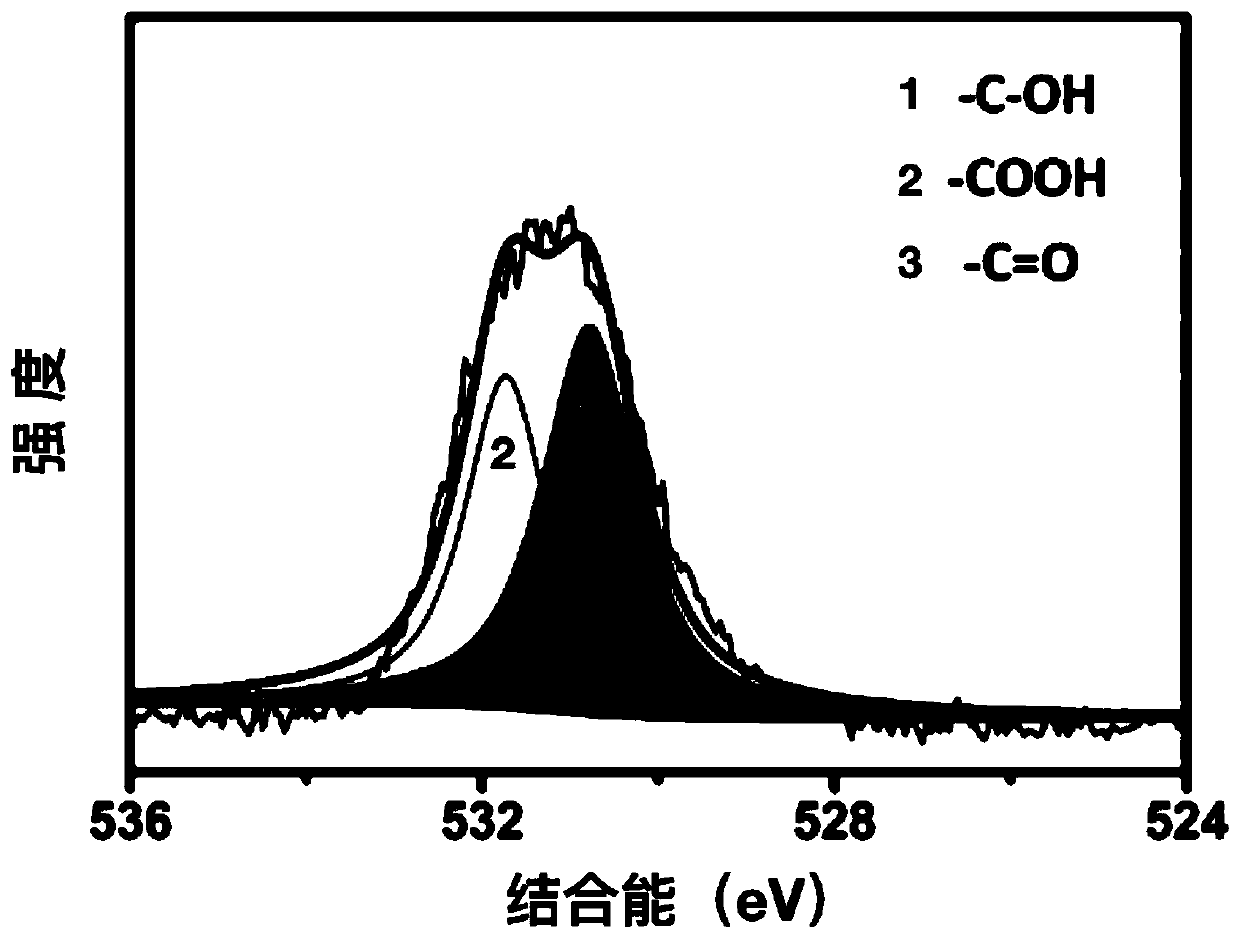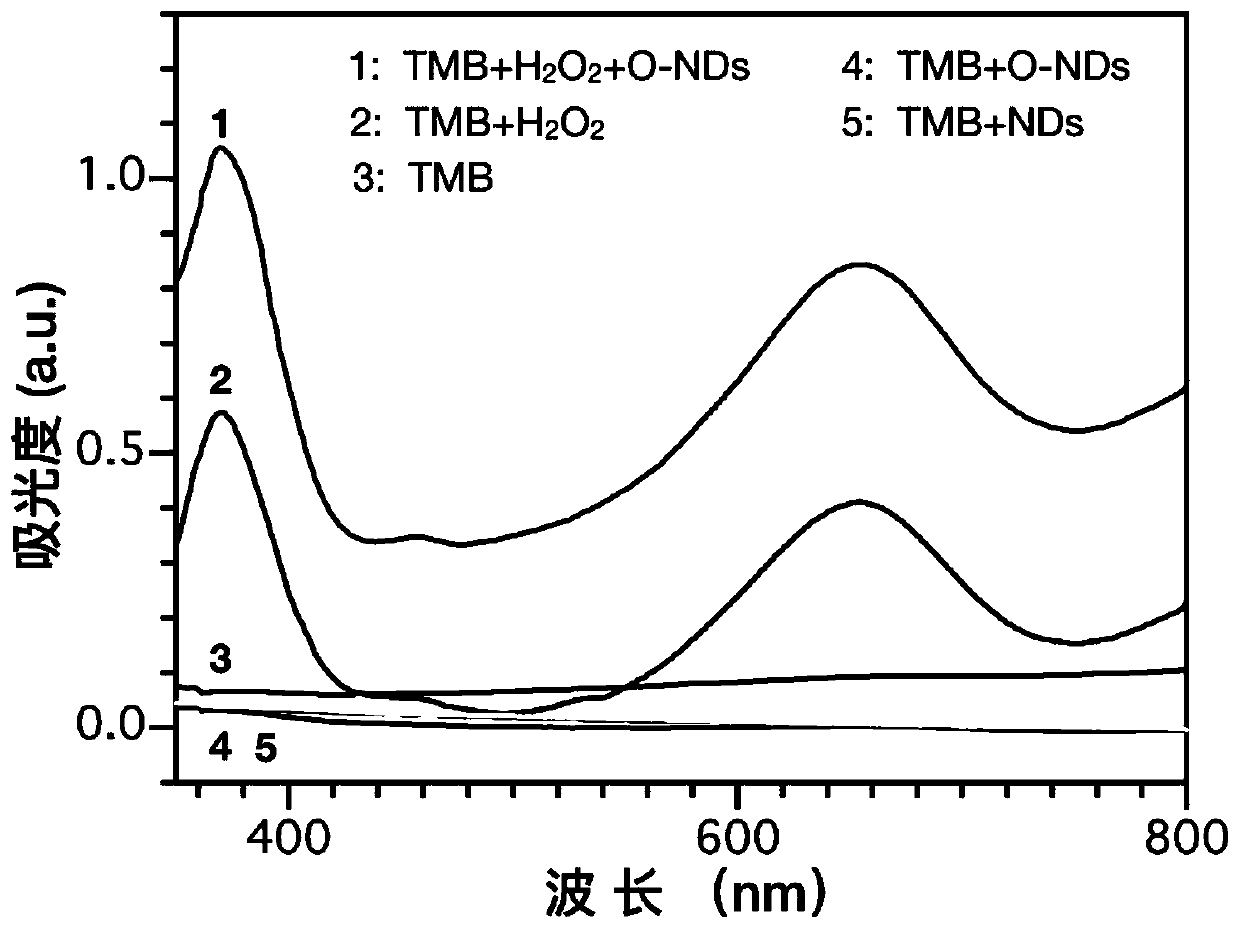Oxygen-containing nano diamond for antibacterial treatment and preparation method thereof
A nano-diamond and oxygen-containing technology, applied in the field of medical antibacterial materials, can solve the problems of being unsuitable for clinical medical applications, unable to destroy plaque biofilm, and not having peroxidase-like activity, achieving low cost and easy operation , The effect of simple preparation process
- Summary
- Abstract
- Description
- Claims
- Application Information
AI Technical Summary
Problems solved by technology
Method used
Image
Examples
Embodiment 1
[0028] The preparation of embodiment 1 oxygen-containing nano-diamond
[0029] Oxygen-containing nano-diamonds containing specific oxygen groups were synthesized by chemical water bath method. Disperse nano-diamond powder with a diameter of 5-10nm in H 2 SO 4 with HNO 3 In the mixture, H 2 SO 4 with HNO 3 The volume ratio was 3:1, heated to 90°C, and continued to react for 24 hours. After the reaction was completed, sodium hydroxide solution was added to the sample for neutralization and cooling. The above samples were dialyzed in a dialysis bag with a cut-off molecular weight of 3500 kDa. Then, the dialysis product was dispersed in a 0.1 mol / mL HCl solution, and heated at 90° C. for 2 hours. Finally, dialyzed again and the product freeze-dried to obtain nanodiamonds (O-NDs) with abundant and specific oxygen-containing groups (transmission electron microscopy images see figure 1 ), the oxygen content on its surface is as figure 2 shown.
Embodiment 2
[0030] Example 2: Detection of enzyme activity of oxygen-containing nanodiamonds
[0031] The absorbance value (625nm) of the O-NDs / TMB system was detected by a UV spectrophotometer. In the experiment, at 25°C, O-NDs was added to an acetate buffer solution (pH 4.0) with a reaction volume of 25mM; before recording the absorbance, Add 1mMTMB to start the reaction; measure the O-NDs at 652nm / TMB / H within 200 seconds 2 o 2 The absorbance value changes within the system, and the peroxidase activity of O-NDs was analyzed using steady-state kinetics. Experimental results such as image 3 , O-NDs in H 2 o 2 In the presence of TMB, it can catalyze the blue reaction of TMB, showing good peroxidase-like activity.
Embodiment 3
[0032] Embodiment 3: Cytotoxicity test detection of oxygen-containing nanodiamond
[0033] Take the gingival fibroblasts grown in the logarithmic phase of the third generation, digest them with 1mL 0.25% trypsin, and divide them according to 6×10 3 Inoculate into a 24-well plate at a concentration of 1 / well and place in CO 2 Constant temperature incubator (5% CO 2 , 95% air, saturated humidity, 37°C) for 24 hours, after changing the medium, add O-NDs, O-NDs concentrations were 0μg / mL, 25μg / mL, 50μg / mL, 100μg / mL, 300μg / mL, 500μg / mL and cell-free group (blank group). After culturing in a constant temperature incubator for 24 hours, 10 μL of CCK-8 solution was added to each well and incubated in an incubator for 1.5 hours under dark conditions. 100 μL per well was transferred to a 96-well plate, and the absorbance value was detected at 450 nm using a microplate reader. The experimental results showed that O-NDs were co-cultured with cells for 24 hours, and no concentration-d...
PUM
 Login to View More
Login to View More Abstract
Description
Claims
Application Information
 Login to View More
Login to View More - R&D
- Intellectual Property
- Life Sciences
- Materials
- Tech Scout
- Unparalleled Data Quality
- Higher Quality Content
- 60% Fewer Hallucinations
Browse by: Latest US Patents, China's latest patents, Technical Efficacy Thesaurus, Application Domain, Technology Topic, Popular Technical Reports.
© 2025 PatSnap. All rights reserved.Legal|Privacy policy|Modern Slavery Act Transparency Statement|Sitemap|About US| Contact US: help@patsnap.com



